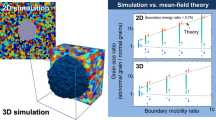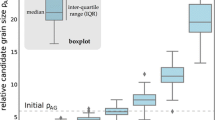Abstract
Abnormal subgrain growth occurs in single-phase materials when the structure contains special subgrains that have growth advantage compared to others in their vicinity by virtue of having unique boundary properties such as low energy and high mobility. Monte Carlo simulations of abnormal subgrain growth were carried out for a wide range of such abnormal growth conditions. For a given abnormal growth condition, the simulation results were found to be sensitive to the choice of the lattice temperature used. When the lattice temperature was too low, the growth kinetics and the shape of the abnormal grain was influenced by the lattice geometry. At higher lattice temperatures, the lattice effects were reduced but the simulation results were scattered around the theoretical prediction of the maximum stable size ratio of the abnormal subgrain to the matrix subgrain. Simulations in which the local lattice temperature was scaled according to the relative boundary energy appeared to reduce the scatter associated with constant lattice temperature simulations, but a discrepancy between theory and simulation was noticed, with the simulations predicting consistently lower values than theoretical. Further simulations with larger system sizes are required in order to better understand the mesoscale issues associated with abnormal subgrain growth.
Similar content being viewed by others
References
D.A. Hughes et al., Acta Metal. 45, 125(1997).
G.B. Sarma, B. Radhakrishnan, and T. Zacharia,Computational Materials Science 12, 105 (1998).
F.J. Humphreys and M. Hatherly, Recrystallization and RelatedAnnealing Phenomena (Pergamon, 1995).
Srolovitz et al.,Scripta Metall. 17, 241 (1983).
M.P. Anderson etal., Acta Metall. 32, 783 (1984).
D.J. Srolovitz, etal. Acta Metal. 32, 793 (1984).
G.S. Grest, D.J. Srolovitz, and M.P. Anderson, Acta Metal. 33, 509 (1985).
M.P. Anderson, G.S. Grest, and D.J. Srolovitz,Phil. Mag B 59, 293 (1989).
G.S. Grest, M.P. Anderson, and D.J. Srolovitz, Phys Rev B 38, 4752 (1988).
D. Fan, C. Geneg, and L.-Q. Chen, Acta Mater45, 1115 (1997).
A. Kazaryan, Y. Wang, S.A. Dregia, and B.R. Patton, Phy Rev B 61, 14275 (2000).
D. Weygand, Y. Brechet, and J. Lepinoux, Phil. Mag B79, 703 (1999).
A. Kuprat, SIAM J Sci Comput.22, 535 (2000).
F.J. Humphreys, Acta Mater.45, 4231 (1997).
A.D. Rollett and W.W. Mullins,Scripta Mater. 36, 975 (1997).
F.J. Humphreysand M. Hatherly, Recrystallization and Related Annealing Phenomena (Elsevier, Oxford, UK, 1995).
A.D. Rollett and E.A. Holm, in Proc. ReX'96 (Monterey, MIIS, 1997) p. 31.
D.C. Hinz and J.A. Szupunar, Phys Rev B 52, 9900(1995).
B. Radhakrishnan and T. Zacharia, Metall. Mater.Trans 26A, 167 (1995).
Author information
Authors and Affiliations
Rights and permissions
About this article
Cite this article
Radhakrishnan, B., Zacharia, T. The Effect of Lattice Temperature on Abnormal Subgrain Growth Simulations using a Monte Carlo Technique. Interface Science 10, 171–180 (2002). https://doi.org/10.1023/A:1015876214079
Issue Date:
DOI: https://doi.org/10.1023/A:1015876214079




